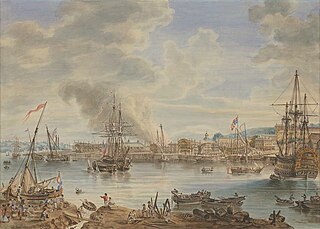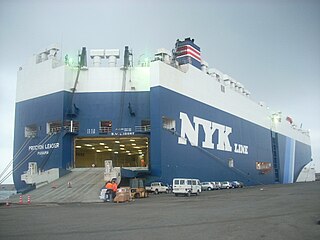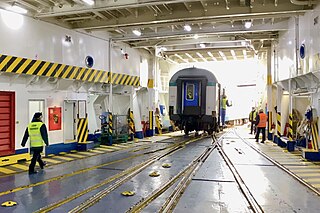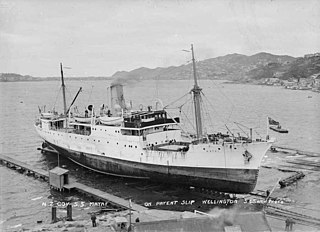
A dry dock is a narrow basin or vessel that can be flooded to allow a load to be floated in, then drained to allow that load to come to rest on a dry platform. Dry docks are used for the construction, maintenance, and repair of ships, boats, and other watercraft.

Chatham Dockyard was a Royal Navy Dockyard located on the River Medway in Kent. Established in Chatham in the mid-16th century, the dockyard subsequently expanded into neighbouring Gillingham.

PS Maid of the Loch is the last paddle steamer built in the United Kingdom. She operated on Loch Lomond for 29 years and as of 2022 is being restored near Balloch pier.

A slipway, also known as boat ramp or launch or boat deployer, is a ramp on the shore by which ships or boats can be moved to and from the water. They are used for building and repairing ships and boats, and for launching and retrieving small boats on trailers towed by automobiles and flying boats on their undercarriage.

Roll-on/roll-off ships are cargo ships designed to carry wheeled cargo, such as cars, motorcycles, trucks, semi-trailer trucks, buses, trailers, and railroad cars, that are driven on and off the ship on their own wheels or using a platform vehicle, such as a self-propelled modular transporter. This is in contrast to lift-on/lift-off (LoLo) vessels, which use a crane to load and unload cargo.

A train ferry is a ship (ferry) designed to carry railway vehicles. Typically, one level of the ship is fitted with railway tracks, and the vessel has a door at the front and/or rear to give access to the wharves. In the United States, train ferries are sometimes referred to as "car ferries", as distinguished from "auto ferries" used to transport automobiles. The wharf has a ramp, and a linkspan or "apron", balanced by weights, that connects the railway proper to the ship, allowing for tidal or seasonal changes in water level.

A shiplift is a modern alternative for a slipway, a floating dry dock or a graving dry dock. A shiplift is used to dry dock and launch ships. It consists of a structural platform that is lifted and lowered exactly vertically, synchronously by a number of hoists. First, the platform is lowered underwater, then the ship is floated above the support, and finally the platform with support and ship is lifted and the ship is brought to the level of the quay.

A ship cradle is a rig designed to hold a ship or boat upright on dry land to allow the vessel to be built or repaired. The vessel is held in place in the cradle by wooden chocks, cables, sand bags or restraining fixtures on the cradle. Ship cradles are made of timber or steel and are usually built adjacent the seashore, lake or river side or on the floor of a dry dock.

The Underfall Yard is a historic boatyard on Spike Island serving Bristol Harbour in England.

Mort's Dock is a former dry dock, slipway, and shipyard in Balmain, New South Wales, Australia. It was the first dry dock in Australia, opening for business in 1855 and closing more than a century later in 1959. The site is now parkland.

Barry Docks is a port facility in the town of Barry, Vale of Glamorgan, Wales, a few miles southwest of Cardiff on the north shore of the Bristol Channel. The docks were opened in 1889 by David Davies and John Cory as an alternative to the congested and expensive Cardiff Docks to ship coal carried by rail from the South Wales Coalfield. The principal engineer was John Wolfe Barry, assisted by Thomas Forster Brown and Henry Marc Brunel, son of the famous engineer Isambard Kingdom Brunel.

Glasson Dock, also known as Glasson, is a village in Lancashire, England, south of Lancaster at the mouth of the River Lune. In 2011, it had a population of around 600.
Williamstown Dockyard was one of Australia's principal ship building yards at Williamstown, Victoria, Australia.

The Creque Marine Railway, formerly the "St Thomas Marine Repair Facility", is an inclined-plane ship railway on Hassel Island, in the bay of Charlotte Amalie off the coast of St. Thomas Island, in the U.S. Virgin Islands. Its site is below Fort Shipley, within Virgin Islands National Park.
Thomas Morton was a Scottish shipwright and inventor. His most widely known invention is the patent slip.
The Dartmouth Marine Slips was an historic shipyard and marine railway which operated in Dartmouth, Nova Scotia between 1859 and 2003. It was noted for important wartime work during the American Civil War as well as during the Battle of the Atlantic in World War II. After its closure, the site began redevelopment as King's Wharf, a high-rise residential development.
Morton Engineering and Dry Dock Company was a shipbuilding company from Quebec City, Quebec. It was located in the Lower Town area of the city, along the Saint-Charles River. Founded in 1858, the shipyard stayed in operation until 1949, when it constructed its last ship. It built ships for the Royal Navy and Royal Canadian Navy during both world wars. In 1947, the company was renamed St. Lawrence Metal and Marine Works.

Tanjung Priok Dock of 4,000 Tons, was a floating dry dock built for Droogdok-Maatschappij Tandjong Priok in the 1890s.

The Great Balance Dock was a floating drydock in New York City. It was the largest such facility in the world when constructed in 1854, and consequently, many of the most important ships of its time were serviced there.

The Evans Bay Patent Slip is a heritage site of the former patent slip located in Evans Bay, in Wellington Harbour in the North Island of New Zealand. The first slipway on the site was commissioned in May 1863 to enable maintenance of the hulls of small vessels. The Wellington Provincial Council was keen to encourage shipping trade by improving facilities in Wellington Harbour and began planning later in 1863 for the construction of a larger patent slip. A concession was granted for the supply, construction and operation of a patent slip on the site. Equipment for the new slip was delivered in 1865 and 1866, but construction was delayed for several years because of a contractual dispute concerning the suitability of the design for the ground conditions. The original suppliers lost a court case and withdrew from the project. The Wellington Patent Slip Company was formed to take over the assets, and construction began in 1871. The Patent Slip was officially opened in March 1873.



















